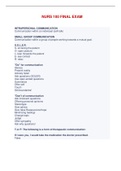NURS 100 FINAL EXAM INTRAPERSONAL COMMUNICATION Communication within an individual (self -talk) SMALL GROUP COMMUNICATION Communication within a group of people working towards a mutual goal. S.O.L.E.R. S- sit facing the patient O- open posture L- lean forwards the patient E- eye contact R- relax "Do" for communication Silence Present reality Actively listen Ask questions (SOLER) Use open -ended questions Summarize Offer self Touch Set boundaries! "Don't of communication Ask irrelevant questions Offerin g personal opinions Stereotype Give advice Give false Reassurance/hope Minimizing feelings Change topic Judge Offer sympathy Ask why questions! T or F: The following is a form of therapeutic communication: If I were you, I would take the medication the d octor prescribed. False T or F: The following is a form of therapeutic communication: Tell me what your concerns are regarding the procedure. True AIDET A-Acknowledge I-Introduce D-Duration E-Explanation T-Thank you ISBAR IDENTIFY SITUATION BACKGROUND ASSESSMENT RECOMMENDATION Pre interaction, orientation, working, resolution (termination) The phases of communication between the nurse and a patient Preinteraction Phase of nurse/ patient interaction which happens prior to meeting patient, gathering information about them (name, DOB Orientation When the nurse and the patient meet, get to know each other, and learn to trust each other, nurse introducing themselves to patient Working When the nurse and the patient work together to solve problems and acco mplish goals Resolution (termination) End of the nurse -client relationship What is the #1 way to prevent the spread of infections? Hand Hygiene Most infections which happen in the health care facility are due to Healthcare workers hands What does the n onspecific innate immune defense system do? it keeps infections out of the body What does the nonspecific innate defense system consist of? Skin, hair, nails, mucous membranes What is the action of the specific adaptive defense system? it finds the pathogens that got into the body through the nonspecific defenses There are a number of ways to stop the chain of infection, describe some of them. Sanitation, disinfection, sterilization, handwashing, isolating, ppe, medical asepsis technique, sterile asepsis technique, cover wounds, keep skin intact, immunizations, diet and exercise, reduce stress Isolation precautions Used when a patient who is at high risk for acquiring microorganisms from either the environment or from other patients, staf f, or visitors Neutropenic isolation Neutropenia (low neutrophils, wbc) -Low WBCs [normal is 5,000 to 10,000] -No fresh flowers -WASH hands, wear a mask, be super clean DVT pneumonia loss of consciousness infection Potential complications after surgery Signs and symptoms of phlebitis at an IV site Erythema, tenderness, drainage, hard palpable cord Immunocompromised When a person has a low number of neutrophils in their immune system, they become Patients with aids or those on immunosuppresants Who is a t risk for being immuncompromised Stress can lead to STRESS Incubation stage of infection Virus is entering the body and first symptoms are showing Prodromal stage of infection During this stage the person is most infectious and symptoms are becoming more specific; pathogen is multiplying Illness stage of infection Signs and symptoms are occurring Convalescence stage of infection Recovery Urinary tract infections, surgical site infections, blood stream infections, and pneumonia -ventilated associated infections are mostly acquired where? Hospital What kinds of patients are at risk for infection? -The immunocompromised -People that go into crowded environments -Older adults -Patients with poor lifestyle choices: unprotected sex, drug users -People wit h poor hygiene -People recently exposed to a virus A systemic infection is known to affect the whole body, what are some clinical manfestions of this? -Fever -Chills -Tachypnea -Tachycardia -Malaise -Fatigue -Nnausea, vomiting, diarrhea -Abdominal cramps -Enlarged lymph nodes A local infection confined to a particular part of the body is indicated by what manifestions? -Erythema -Warmth -Edema -Pain at site -Drainage Is pain considered a systemic or localized infection? Local What are some labs that are drawn and lab values that will indicate an infection? Leukocytosis: WBC greater than 10,000 ESR (erythrocyte sedimentation rate) greater than 20 MM/HR




